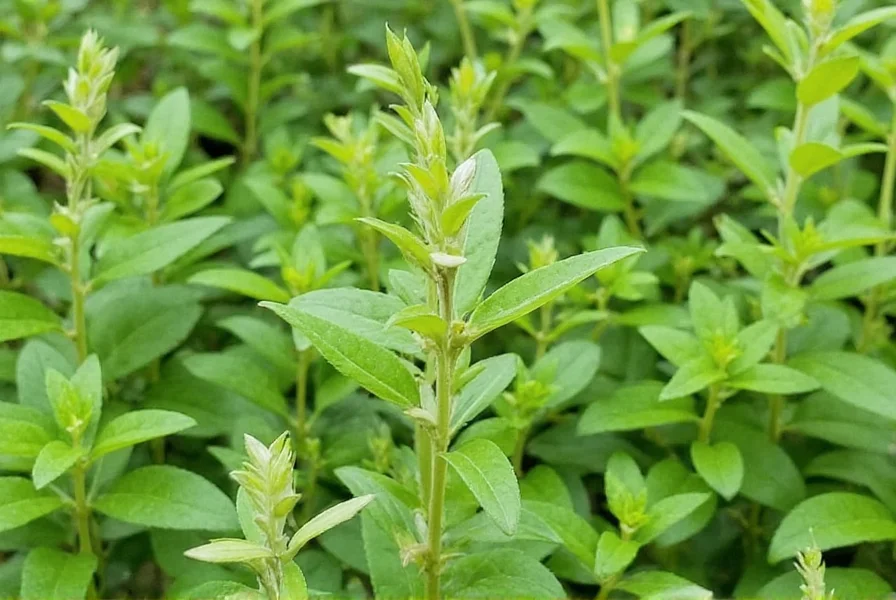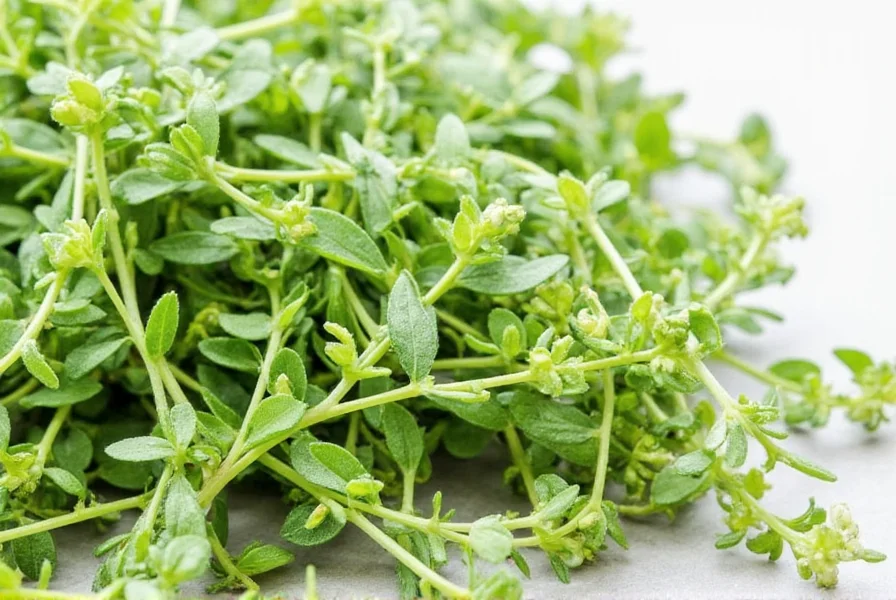Summer savory (Satureja hortensis) is a versatile culinary herb with a mild peppery flavor and citrus notes, perfect for enhancing soups, stews, and meats. It's a staple in Mediterranean cuisine and offers a subtle yet distinctive taste without overpowering dishes.
Table of Contents
What is Summer Savory?
Satureja hortensis, commonly known as summer savory, is a fragrant herb that belongs to the Lamiaceae family. Native to southern Europe and the Mediterranean region, it has been used in cooking and traditional medicine for centuries. Unlike its close relative, winter savory (Satureja montana), which is more pungent and woody, summer savory has a milder, slightly peppery flavor with hints of thyme and lemon.
This herb is often grown in gardens and can be harvested multiple times during the growing season. Its small, narrow leaves are aromatic and best used fresh or dried. In some cuisines, especially in French and Italian cooking, summer savory is a staple ingredient, adding a bright, herbal note to dishes like soups, stews, and meat preparations.
Flavor Profile and Uses
The flavor of summer savory is distinct—mildly spicy, with a hint of citrus and a touch of minty freshness. It's not overpowering, making it ideal for delicate dishes where you want to enhance rather than dominate the taste. Its versatility makes it a favorite among both amateur cooks and professional chefs.
Here are some common uses:
- Cooking: Add fresh or dried summer savory to tomato-based sauces, vegetable medleys, and egg dishes.
- Herbal Infusions: Brew it into a tea for a refreshing and soothing drink.
- Marinades: Use it in marinades for chicken, fish, and tofu to add depth and complexity.
- Seasoning: Sprinkle over roasted potatoes, grilled vegetables, or salads for an extra layer of flavor.
Recipes Using Summer Savory
Here are two simple recipes to try:
- Summer Savory Roasted Chicken: Rub chicken with olive oil, salt, pepper, and 1 tsp dried summer savory. Roast at 375°F for 45 minutes. Garnish with fresh summer savory leaves.
- Bean Soup with Summer Savory: In a pot, sauté onions and garlic. Add canned beans, tomatoes, broth, and 1 tsp dried summer savory. Simmer for 20 minutes. Serve with crusty bread.
Practical Tips for Using Summer Savory
Whether you're a seasoned chef or just starting out, here are some practical tips to make the most of this versatile herb:
- Use Fresh for Maximum Flavor: Fresh summer savory has a brighter, more vibrant taste compared to dried. If you have access to it, use it right away.
- Dry It for Long-Term Storage: If you can't use it all at once, dry the leaves in a cool, dark place. Store them in an airtight container to preserve their potency.
- Pair with Complementary Flavors: Summer savory works well with garlic, olive oil, tomatoes, and herbs like rosemary and oregano.
- Don't Overdo It: Even though it's mild, too much can overpower a dish. Start with a small amount and adjust to taste.
- Experiment with Different Cuisines: Try using it in Mediterranean, Middle Eastern, or even Asian dishes for a unique twist.
Buying Guide for Summer Savory
If you're looking to buy summer savory, there are several options depending on your needs and preferences. Here's a detailed guide to help you choose the right product:
1. Fresh Summer Savory
Available at local farmers' markets, specialty grocery stores, or online retailers. Look for vibrant green leaves without any yellowing or wilting. Fresh summer savory is best used within a few days of purchase.

2. Dried Summer Savory
Dried summer savory is a convenient option for long-term storage. It can be found in spice sections of supermarkets or specialty shops. When purchasing, check the packaging date to ensure freshness. Dried summer savory is ideal for baking, seasoning, and infusions.
3. Seed Packets
If you're interested in growing your own summer savory, seed packets are available from gardening suppliers. These are perfect for home gardeners who want to cultivate the herb themselves. Choose high-quality seeds from reputable brands to ensure good germination rates.

4. Herbal Teas and Supplements
Some companies offer summer savory in the form of herbal teas or dietary supplements. These are typically marketed for digestive health and stress relief. If you're interested in these products, look for organic and certified brands that follow quality control standards.
5. Seasonal and Organic Options
For those who prioritize sustainability, organic and locally sourced summer savory is an excellent choice. These products are free from synthetic pesticides and support eco-friendly farming practices.
Comparison Table with Similar Herbs
| Herb | Flavor Profile | Best Used With | Storage |
|---|---|---|---|
| Summer Savory (Satureja hortensis) | Mildly peppery with citrus and mint notes | Tomato sauces, soups, eggs, grilled vegetables | Fresh: 3–5 days; Dried: 6–12 months |
| Thyme | Earthiness with a slight floral note | Roasted meats, stews, breads | Fresh: 1–2 weeks; Dried: 1–2 years |
| Oregano | Pungent, earthy, and slightly bitter | Italian dishes, pizzas, Mediterranean recipes | Fresh: 1 week; Dried: 1–2 years |
| Rosemary | Piney and aromatic | Roast chicken, lamb, breads | Fresh: 1–2 weeks; Dried: 1–2 years |
| Marjoram | Mild, sweet, and slightly citrusy | Stuffed vegetables, sauces, meatloaf | Fresh: 1 week; Dried: 1–2 years |
Frequently Asked Questions
What is Summer Savory?
Summer savory (Satureja hortensis) is a fragrant herb belonging to the Lamiaceae family. Native to southern Europe and the Mediterranean region, it's widely used in cooking for its mild peppery flavor with citrus notes. Unlike winter savory (Satureja montana), summer savory has a more delicate flavor profile and is an annual plant rather than perennial.
How does summer savory differ from winter savory?
Summer savory (Satureja hortensis) has a milder, more delicate flavor compared to winter savory (Satureja montana). Winter savory is more pungent, woody, and robust, making it better suited for long-cooking dishes. Summer savory is an annual plant with thinner leaves, while winter savory is a perennial with thicker, more needle-like leaves. Summer savory is generally preferred for fresh applications and delicate dishes.
What are the health benefits of summer savory?
Summer savory has been used traditionally for digestive health and as an antiseptic. It contains antioxidants and may help with digestion, respiratory issues, and has antimicrobial properties. Some studies suggest it may have anti-inflammatory effects. However, more research is needed to confirm these benefits, and it should not replace medical treatment for health conditions.
How should I store fresh summer savory?
To store fresh summer savory, wrap the stems in a slightly damp paper towel and place in a plastic bag in the refrigerator. It will stay fresh for 3-5 days. For longer storage, you can freeze the leaves in ice cube trays with water or olive oil. Dried summer savory should be stored in an airtight container away from light and heat, where it will maintain its flavor for 6-12 months.
What dishes work best with summer savory?
Summer savory complements bean dishes, tomato sauces, roasted vegetables, grilled meats (particularly poultry and fish), egg preparations, and stuffing. It's a traditional ingredient in French herb mixtures and works well in Mediterranean cuisine. Its mild flavor makes it versatile for both fresh and cooked applications without overwhelming other ingredients.
Can I grow summer savory at home?
Yes, summer savory is relatively easy to grow in home gardens. It prefers full sun and well-drained soil. Plant seeds after the last frost, spacing them 10-12 inches apart. The plants reach 12-18 inches in height and will flower in summer. Harvest leaves before flowering for the best flavor. It's an annual plant, so you'll need to replant each year.
Conclusion
Summer savory is a remarkable herb that brings a unique blend of flavor and fragrance to your kitchen. Whether you're using it fresh or dried, it adds a subtle yet distinctive character to a wide range of dishes. From its mild, peppery undertones to its compatibility with various cuisines, this herb is a must-have for any spice enthusiast or professional cook.
Remember to store it properly, experiment with different recipes, and enjoy the zesty twist that summer savory can bring to your meals. With a little knowledge and a bit of creativity, you'll discover new ways to incorporate this wonderful herb into your cooking routine.

So next time you're in the kitchen, don't forget to reach for a sprig of summer savory. It might just be the secret ingredient you've been looking for!










 浙公网安备
33010002000092号
浙公网安备
33010002000092号 浙B2-20120091-4
浙B2-20120091-4